Flexural Strength of Beams
Flexural Strength of BeamsIncorporating Copper Slag as Partial Replacement of Fine Aggregate in Concrete
Mrs. D. Brindha, Senior Lecturer, Dr. S. Nagan, Assitant Professor, Dept. of Civil Engineering, Thiagarajar College of Engineering, Madurai
Copper slag is obtained as waste product from the sterlite industries, which produces copper in the form of cathode. Investigations were carried out to explore the possibility of using copper slag as a replacement of sand in concrete mixtures. This paper presents the results of study undertaken to investigate the feasibility of using copper slag as fine aggregate in concrete. The effects of replacing fine aggregates by copper slag on the compressive strength of cubes, split tensile strength of cylinders and flexural strength of beams are evaluated in this study. Five test groups were constituted with the replacement percentages of 0%, 20%, 30%, 40%, and 50% .The results showed the effect of copper slag on RCC concrete elements has a considerable amount of increase in the compressive, split tensile and flexural strength characteristics. Leaching studies revealed that copper slag does not leach heavy metals like Pb, Zn, Cr, Ni, Mo etc and also indicates that the leaching of heavy metals was well below the toxicity limits even under aggressive conditions.
The Government of India has targeted the year 2010 for providing housing for all [2]. such large scale housing construction activities require huge amount of money. Out of the total cost of construction, building materials contribute to about 70% of cost in developing countries like India. Therefore, the need of the hour is replacement of costly and scarce conventional building materials by innovative, cost effective and environment– friendly alternate building materials. The new material should be environment–friendly and preferably utilize industrial wastes generated as a result of rapid industrialization.
Copper slag is one of the materials that is considered as a waste material which could have a promising future in construction industry as partial or full substitute of either cement or aggregates. It is a byproduct obtained during the matte smelting and refining of copper [3]. Since it has a higher composition of Fe2O3 the density of copper slag is relatively higher when compared to other materials.
Sterlite industries (India) ltd, Tuticorin, India produces 4 lakh tons of copper per year [4]. For every ton of copper production, about 2.2 tons of copper slag is generated. Therefore, in India 8 lakh tons of copper slag is generated every year. It was obtained as a result of manufacturing of copper electrodes in sterlite industry.
Copper slag have been widely used for abrasive tools, roofing granules, cutting tools, abrasive, tiles, glass, road base construction, rail road ballast and cement and concrete industries[5]. Several researchers have investigated the possible use of copper slag as fine and coarse aggregates in normal concrete and its effect on different mechanical properties of mortar and concrete. Some studies were carried using fine powder copper slag for partial replacement of cement [6]. There are no studies available about the copper slag effect on structural members like RCC beams and RCC columns.
The pozzolanic activity of copper slag has been investigated by O.Pavez etdl. The effect of copper slag on the hydration of cement was investigated by Mobasher et al. [8] and Tixier et al. [9]. Up to 50% by weight of copper slag was used as a Portland cement replacement together with up to 1.5% of hydrated lime as an activator to pozzolanic reaction. Result indicated a significant increase in the compressive strength. Khalifa,S.al/zabri investigated the performance of high strength concrete made with copper slag as a fine aggregate[11]. The results indicated that water demand reduced by 22% at 100% copper slag replacement compared to the control mixture. The strength and durability of HSC were generally improved with the increase of copper slag content in the concrete mixture.
Although there are many studies that have been reported by investigators from other countries on the use of copper slag in cement concrete, not much research has been carried out in India concerning the incorporation of copper slag in concrete. Therefore, this paper presents the study of the effect of copper slag as a supplementary fine aggregate in concrete member like RCC beams. Flexural strength of RCC beams was investigated for the various proportion of copper slag as a sand substitute in concrete.

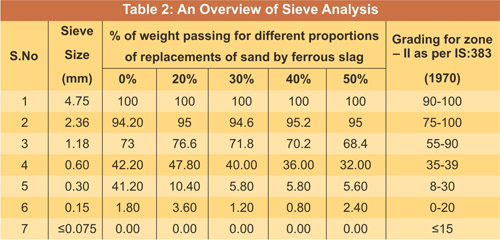
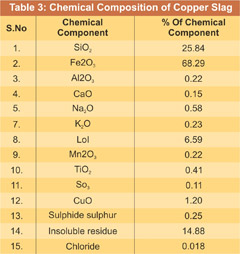
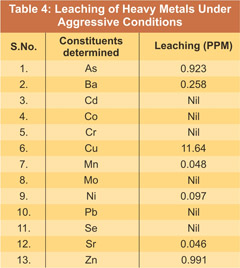 Copper slag samples were analysed for constituent oxides including minor oxides and heavy elements besides mineral phases. The results of chemical analysis are shown in Table-3.
Copper slag samples were analysed for constituent oxides including minor oxides and heavy elements besides mineral phases. The results of chemical analysis are shown in Table-3.
The leaching of heavy metals in copper slag samples was tested by National Council for Cement and Building Materials, New Delhi as per the method given in ASTM D-5233-1995d which involves sample treatment under aggressive conditions. The results presented in Table-4 indicate that the leaching of heavy metals was well below the toxicity limits even under aggressive conditions.Materials
The cement used in this study was ordinary Portland cement (OPC) of grade 43. The specific gravity of cement is 3.15.
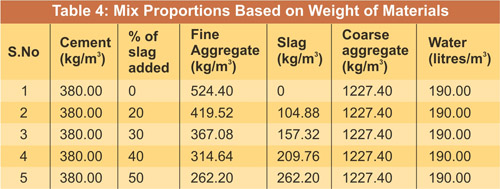
Water : Cement : Fine Aggregate : Coarse Aggregate
0.50 : 1 : 1.38 : 3.23
Five concrete mixtures with different proportions of copper slag ranging from 0% to 50% were considered as shown in Table-5 the materials were mixed in a laboratory concrete mixture. The overall mixing time was about 3 minutes. The mixtures were compacted using vibrating table. The slump of the fresh concrete was determined to ensure that it would be within the designing value and to study the effect of copper slag replacement on the workability of concrete. The specimens were demoulded after 24 hours, cured in water and than tested at room temperature at the required age.
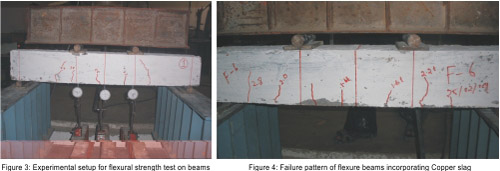
The split tensile strength of concrete is calculated by using the following formula
fst = 2P / π ld
where
P- maximum load at failure
l-length of cylindrical specimen in mm
d-diameter of cylindrical specimen in mm.
Series A consisted of three beams designated as A1, A2 and A3. These beams were treated as control specimens and were not replaced with copper slag.
Series B consisted of three beams designated as B1, B2 and B3. 20% of copper slag was replaced for fine aggregate in concrete. Similarly, series C, D and E consisted of C1, C2, C3, D1, D2, D3 and E1, E2, E3 beams replaced with 30%, 40% and 50% of copper slag. To conduct the test the beam specimens were placed on the loading frame. Plumb bop was used to correct the center of the beam. Two distance pieces were kept at the one third distances from both the ends. Loading frame was placed upon the distance pieces and its centre was corrected using plumb bob. Load cell was placed on the beam top and corrected to its centre by using plumb bop. Load cell was connected by the load indicator; three deflectometers were placed on the bottom side of the beam. Two point loading system was adopted for the test.Test Results and Discussion
The average 28 days compressive strength for different proportions of concrete mixes shown in fig. The results show that the compressive strength of concrete is increased as copper slag quantity increases up to 40% addition, beyond that the was reduced due to comp. strength significant increase in free water content in the mixes. The excessive free water content in the mixes with copper slag content causes the bleeding and segregation in concrete. Therefore, it leads reduction in the concrete strength.
Table-5 gives Results of the compressive strength test conducted on cube specimens at 28 days.
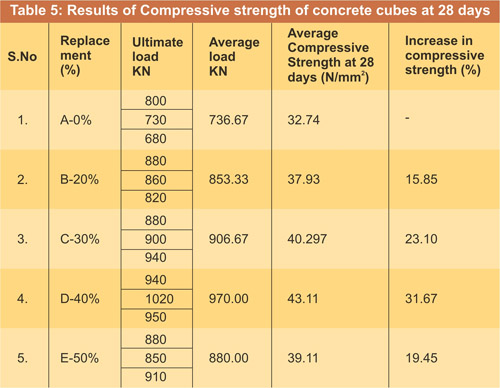
The highest compressive strength was achieved with 40% replacement of copper slag, which was found about 43N/mm2. This means that there is an increase of compressive strength of more than 30% compared to the control mix. However mix with 50% replacement of copper slag gave the low compressive strength when compare to 40% but still more than 20% compared to the control mix. The results showed that the uses of copper slag as a replacement of sand in concrete mixes resulted high compressive strength of about 30%.
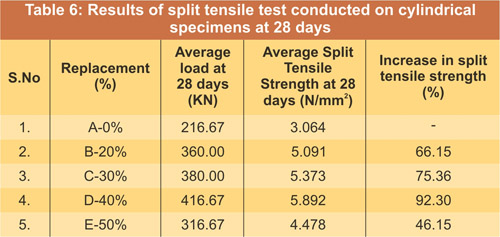
The tensile strength of concrete showed similar behavior to the compressive strength. The results show that the split tensile strength is increased as copper slag quantity increases up to 40% addition, beyond that the split tensile strength value slightly reduces but still more than 45% compared with control mix. The results showed that the use of copper slag in concrete increases the tensile strength of about 90% with that of control mixture.
The average modulus of rupture (flexural strength) was determined using the following expression
Fcr = PL / BD2
Where Fcr = modulus of rupture
P = ultimate load in KN
L = length of beam in m
B = Average width of specimen in m
D = Average depth of specimen in m
All of the beams tested failed in flexure with crushing of concrete in the compression zone at the failure stage after the development of flexural cracks. The first visible cracks formed between the locations of the two point loads in the region of maximum bending moment.
Thereafter, as the load was increased more cracks started to form over the shear span on both sides of the beam. Flexural beams replaced with copper slag gives more flexural strength compared to the control specimens. The results showed the significant increase of flexural strength of beams when copper slag was added for the replacement of sand.
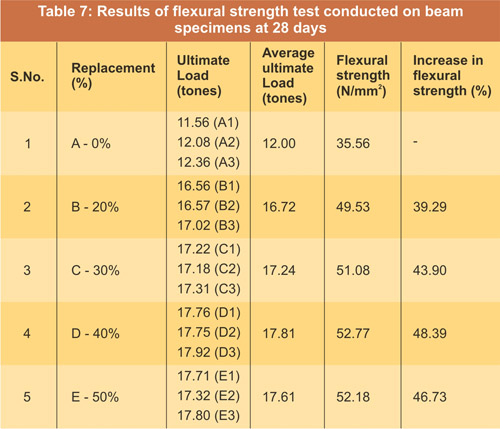
The load deflection curve indicates that the copper slag replaced concrete specimens are withstanding for higher loads. The energy absorption of these beams was calculated as the area under the load Vs deflection curves for flexure failure. From the values, it was observed that the copper slag replaced beams showed an increase in energy absorption values. This enhancement in energy absorption of beams could be attributed to the ductile nature of the copper slag beams.
Mrs. D. Brindha, Senior Lecturer, Dr. S. Nagan, Assitant Professor, Dept. of Civil Engineering, Thiagarajar College of Engineering, Madurai
Copper slag is obtained as waste product from the sterlite industries, which produces copper in the form of cathode. Investigations were carried out to explore the possibility of using copper slag as a replacement of sand in concrete mixtures. This paper presents the results of study undertaken to investigate the feasibility of using copper slag as fine aggregate in concrete. The effects of replacing fine aggregates by copper slag on the compressive strength of cubes, split tensile strength of cylinders and flexural strength of beams are evaluated in this study. Five test groups were constituted with the replacement percentages of 0%, 20%, 30%, 40%, and 50% .The results showed the effect of copper slag on RCC concrete elements has a considerable amount of increase in the compressive, split tensile and flexural strength characteristics. Leaching studies revealed that copper slag does not leach heavy metals like Pb, Zn, Cr, Ni, Mo etc and also indicates that the leaching of heavy metals was well below the toxicity limits even under aggressive conditions.
Introduction
Large amounts of industrial waste or by-products accumulate every year in the developing countries. Sustainability and resource efficiency are becoming increasing by most important issues in today’s construction industry. Therefore, nowadays utilization of secondary materials is being encouraged in construction field. For the production of cement and concrete, very high amount of energy is needed. Around 7% of CO2 released to the atmosphere is generated during cement production [1]. Harmful effects of concrete on environment can be reduced by producing good and durable concrete by using industrial byproducts.The Government of India has targeted the year 2010 for providing housing for all [2]. such large scale housing construction activities require huge amount of money. Out of the total cost of construction, building materials contribute to about 70% of cost in developing countries like India. Therefore, the need of the hour is replacement of costly and scarce conventional building materials by innovative, cost effective and environment– friendly alternate building materials. The new material should be environment–friendly and preferably utilize industrial wastes generated as a result of rapid industrialization.
Copper slag is one of the materials that is considered as a waste material which could have a promising future in construction industry as partial or full substitute of either cement or aggregates. It is a byproduct obtained during the matte smelting and refining of copper [3]. Since it has a higher composition of Fe2O3 the density of copper slag is relatively higher when compared to other materials.
Sterlite industries (India) ltd, Tuticorin, India produces 4 lakh tons of copper per year [4]. For every ton of copper production, about 2.2 tons of copper slag is generated. Therefore, in India 8 lakh tons of copper slag is generated every year. It was obtained as a result of manufacturing of copper electrodes in sterlite industry.
Copper slag have been widely used for abrasive tools, roofing granules, cutting tools, abrasive, tiles, glass, road base construction, rail road ballast and cement and concrete industries[5]. Several researchers have investigated the possible use of copper slag as fine and coarse aggregates in normal concrete and its effect on different mechanical properties of mortar and concrete. Some studies were carried using fine powder copper slag for partial replacement of cement [6]. There are no studies available about the copper slag effect on structural members like RCC beams and RCC columns.
The pozzolanic activity of copper slag has been investigated by O.Pavez etdl. The effect of copper slag on the hydration of cement was investigated by Mobasher et al. [8] and Tixier et al. [9]. Up to 50% by weight of copper slag was used as a Portland cement replacement together with up to 1.5% of hydrated lime as an activator to pozzolanic reaction. Result indicated a significant increase in the compressive strength. Khalifa,S.al/zabri investigated the performance of high strength concrete made with copper slag as a fine aggregate[11]. The results indicated that water demand reduced by 22% at 100% copper slag replacement compared to the control mixture. The strength and durability of HSC were generally improved with the increase of copper slag content in the concrete mixture.
Although there are many studies that have been reported by investigators from other countries on the use of copper slag in cement concrete, not much research has been carried out in India concerning the incorporation of copper slag in concrete. Therefore, this paper presents the study of the effect of copper slag as a supplementary fine aggregate in concrete member like RCC beams. Flexural strength of RCC beams was investigated for the various proportion of copper slag as a sand substitute in concrete.
Physical and Chemical Properties
The copper slag is glassy in nature and has a similar particle size range to sand, indicating that it could be used as a replacement for the sand present in cementitious mixture. The Table-1 shows the physical properties of copper slag replaced with sand. Copper slag has a black color and glassy appearance. The specific gravity of copper slag varies from 3.5 to 4.0. The Unit weight of copper slag concrete is somewhat higher than that of conventional concrete. The weight of copper slag concrete is increasing in the range of 10 to 15% from the conventional concrete. Water absorption of copper slag is typically very low (0.361) when compared to sand. Bulk density of copper slag varies from 1.6 to 2.20 g/cc. It has high friction angle due to sharp angular shape. Since copper slag contains proper angular particles, mostly between 4.75mm to 75 micron in size, it confirms to zone II as per IS-383 shown in Table-2.

Chemical Composition of Copper Slag


Leaching of heavy elements in copper slag
Copper slag samples were dipped in distilled water and studied for leaching of heavy metals from them up to a period of 15 days using ICP technique. No leaching of heavy metals such as Pb, Zn, Cr, Ni, Mo etc was observed. Leaching of very small quantities of Ba (0.008 ppm), Cu (0.087 ppm), Mn (0.008 ppm) and Sr (0.002 ppm) was however observed at 15 days.The leaching of heavy metals in copper slag samples was tested by National Council for Cement and Building Materials, New Delhi as per the method given in ASTM D-5233-1995d which involves sample treatment under aggressive conditions. The results presented in Table-4 indicate that the leaching of heavy metals was well below the toxicity limits even under aggressive conditions.
Materials
Cement
The cement used in this study was ordinary Portland cement (OPC) of grade 43. The specific gravity of cement is 3.15.
Fine aggregates and coarse aggregates
Coarse aggregates are purchased from a nearby crusher in Madurai. Coarse aggregate with a nominal maximum size of 20mm were used in this study. The fine aggregate was river sand taken from Vaigai River, Madurai which has the specific gravity of 2.55 and bulk density of 1.61.Copper slag
Copper slag is a by-product obtained during the production of copper in copper industries. Copper slag used in this work was brought from Sterlite industries (India) Ltd, Tuticorin which produces annual average of 8 lakh tones of copper.Laboratory Testing Program and Mix Proportions
The mix proportion chosen for this study is given Table-4. The following mix proportion is adopted as per IS-10262.
Water : Cement : Fine Aggregate : Coarse Aggregate
0.50 : 1 : 1.38 : 3.23
Five concrete mixtures with different proportions of copper slag ranging from 0% to 50% were considered as shown in Table-5 the materials were mixed in a laboratory concrete mixture. The overall mixing time was about 3 minutes. The mixtures were compacted using vibrating table. The slump of the fresh concrete was determined to ensure that it would be within the designing value and to study the effect of copper slag replacement on the workability of concrete. The specimens were demoulded after 24 hours, cured in water and than tested at room temperature at the required age.
Cube compressive strength
To determine the compressive strength, cube moulds of size 150x150x150 mm were used. 15 cubes were caste with different proportions of copper slag. They were cleaned thoroughly using a waste cloth and then properly oiled along its faces. Concrete was then filled in mould and then compacted using a standard tamping rod of 60 cm length having a cross sectional area of 225mm2.Reinforcement Detailing

Experimental test set up

Split tensile strength
To determine the split tensile strength, cylinder moulds of diameter 150mm and length 300mm were casted. Totally, 15 cylindrical specimens were casted with different proportions of copper slag. The crude oil was applied as seen earlier along the inner surfaces of the mould for the easy removal of casted cylinder from the mould. Concrete was poured throughout its length and compacted well.The split tensile strength of concrete is calculated by using the following formula
fst = 2P / π ld
where
P- maximum load at failure
l-length of cylindrical specimen in mm
d-diameter of cylindrical specimen in mm.
Flexural strength of beams
The size of beam specimens is 1000 x150 x150mm. The beam specimens were cast and tested with and without copper slag for normal conditions. 15 Nos of beam specimens were cast using the same reinforcement shown in Figure. the beams were divided into five series A, B, C, D and E.Series A consisted of three beams designated as A1, A2 and A3. These beams were treated as control specimens and were not replaced with copper slag.
Series B consisted of three beams designated as B1, B2 and B3. 20% of copper slag was replaced for fine aggregate in concrete. Similarly, series C, D and E consisted of C1, C2, C3, D1, D2, D3 and E1, E2, E3 beams replaced with 30%, 40% and 50% of copper slag. To conduct the test the beam specimens were placed on the loading frame. Plumb bop was used to correct the center of the beam. Two distance pieces were kept at the one third distances from both the ends. Loading frame was placed upon the distance pieces and its centre was corrected using plumb bob. Load cell was placed on the beam top and corrected to its centre by using plumb bop. Load cell was connected by the load indicator; three deflectometers were placed on the bottom side of the beam. Two point loading system was adopted for the test.
Test Results and Discussion
Effect of copper slag on compressive strength of concrete
The average 28 days compressive strength for different proportions of concrete mixes shown in fig. The results show that the compressive strength of concrete is increased as copper slag quantity increases up to 40% addition, beyond that the was reduced due to comp. strength significant increase in free water content in the mixes. The excessive free water content in the mixes with copper slag content causes the bleeding and segregation in concrete. Therefore, it leads reduction in the concrete strength.Table-5 gives Results of the compressive strength test conducted on cube specimens at 28 days.

The highest compressive strength was achieved with 40% replacement of copper slag, which was found about 43N/mm2. This means that there is an increase of compressive strength of more than 30% compared to the control mix. However mix with 50% replacement of copper slag gave the low compressive strength when compare to 40% but still more than 20% compared to the control mix. The results showed that the uses of copper slag as a replacement of sand in concrete mixes resulted high compressive strength of about 30%.
Effect of Copper Slag on Split Tensile Strength of Concrete
Totally 15 cylindrical specimens were tested for finding split tensile strength in accordance with ASTM C 496-96. the splitting tensile strength was determined by using the following formulae Ft = 2P / π LD. The results from the splitting tensile test at 28 days are presented in Table-6.
The tensile strength of concrete showed similar behavior to the compressive strength. The results show that the split tensile strength is increased as copper slag quantity increases up to 40% addition, beyond that the split tensile strength value slightly reduces but still more than 45% compared with control mix. The results showed that the use of copper slag in concrete increases the tensile strength of about 90% with that of control mixture.
Effect of copper slag on flexural strength of RCC beams
Fifteen beams were also tested for flexural strength under two point loading conditions. Out of the 15 specimens A1,A2,A3, were treated as control specimens, remaining set of specimens incorporating copper slag at a percentage of 20%, 30%, 40% and 50% with that of sand.The average modulus of rupture (flexural strength) was determined using the following expression
Fcr = PL / BD2
Where Fcr = modulus of rupture
P = ultimate load in KN
L = length of beam in m
B = Average width of specimen in m
D = Average depth of specimen in m
All of the beams tested failed in flexure with crushing of concrete in the compression zone at the failure stage after the development of flexural cracks. The first visible cracks formed between the locations of the two point loads in the region of maximum bending moment.
Thereafter, as the load was increased more cracks started to form over the shear span on both sides of the beam. Flexural beams replaced with copper slag gives more flexural strength compared to the control specimens. The results showed the significant increase of flexural strength of beams when copper slag was added for the replacement of sand.

The load deflection curve indicates that the copper slag replaced concrete specimens are withstanding for higher loads. The energy absorption of these beams was calculated as the area under the load Vs deflection curves for flexure failure. From the values, it was observed that the copper slag replaced beams showed an increase in energy absorption values. This enhancement in energy absorption of beams could be attributed to the ductile nature of the copper slag beams.
Conclusion
The following conclusions may be drawn from the study of the effect of copper slag replacement on the concrete properties- The addition of copper slag has improved the compressive strength, split tensile strength and flexural strength of concrete.
- The results also revealed that addition of the slag in concrete increases the density of about 10 to 20% thereby the self–weight of the concrete.
- The slump value of copper slag concrete lies between 75 to 100 mm.
- The flexural strength test on beams results show that the ultimate load carrying capacity of the beam increases by 30% for 40% replacement of copper slag.
- The uses of copper slag as a partial replacement for sand impart strength up to 50% replacement level. Higher level replacement leads to segregation and bleeding.
- Water absorption value of copper slag concrete is reducing upto 40%. After that the surface water absorption is increased rapidly.
- The leachant studies revealed that the addition of slag does not pave way for leaching of harmful elements like Copper (Cu) and Iron (Fe) present in slag in concrete. Thus, it does not pose any environmental problem.
- It was observed that the copper slag replaced beams showed an increase in energy absorption values
Acknowledgment
The authors wish to acknowledge Thiagarajar College of Engineering, Madurai and Sterlite Industries (India) Ltd., Tuticorin, India for providing all the facilities for carrying out this work. The statistical data of leaching studies of copper slag, collected from the report submitted by National council for cement and building materials, New Delhi, July 2009.References
- Mehta P.K. Greening of the concrete industry for sustainable development, concr.Int.2002: 24(7);23-7).
- Fly ash: A resource material for innovative building material- Indian perspective C. N. Jha & J. K. Prasad.
- Gorai P, Jana RK, Premchand, characteristics and utilization of copper slag, a review. Resource conserve.recy 2003;39;299-313
- Global slag magazine, may2007
- Mostafa khanzadi, ali behnood.mechanical properties of high strength concrete incorporating copper slag as coarse aggregate.
- Copper slag waste as supplementary cementing material to concrete. W.A.Moura, J.P.Goncalves, M.B. Leirelima, 23 jan 2007
- O.Pavez, F.Rojas, J.Palacios, A.Nazer. pozzolanic activity of copper slag. Conference on clean technologies for the mining industry, 2003
- Mobasher B,devaguptapu R, arino AM. Effect of copper slag on the hydration of blended cementitious mixtures. Proceedings of the ASCE materials engineering conference. Materials for the new millennium :1996, P/1677/86.
- Tixier R, devagupta R, Mobasher B, the effect of copper slag on the hydration and mechanical properties of cementitious mixture. Cement concrete Res, 1997;27 (10):1569-80.
- Boncukcuoglu R, Kocakerim MM, Tosunoglu V. Utilization of industrial boron wastes cement production for the stabilization. Energy Education Science and Technology 1999;3 (1):48–54.
- Demirboga R, Sahin R, Bingol F, Gul R. The Usability of blast furnace slag in the production of high strength concrete. Fifth international symposium on utilization of high strength/high performance concrete. Norway: Sandefjord; 1999.p. 1083–91.
- Demirboga R, Orung I, Gul R. Effects of expanded perlite aggregate and mineral admixtures on the compressive strength of low density concretes. Cement and Concrete Research 2001;31 (11):1627–32.
- Ghafoori N, Bulholc J. Investigation of lignite-based bottom ash for structural concrete. Journal of Materials in Civil Engineering 1996;8 (3):128–37
- Haque MN, Kayyali OA, Joynes BM. Blast furnace slag aggregate in the production of high performance concrete. American Concrete Institute 1995;SP 153:911–30.
- Kayali O, Haque MN, Zhu B. Drying shrinkage of fiber rienforced lightweight aggregate concrete containing fly ash. Cement and Concrete Research 1999;29:1835–40.
- Mehta PK. Durability critical issues for the future. Concrete International 1997;19(7):69–76.
- Alp.I, Devaki.H, Sungan. H, Utilization of floatation wastes of copper slag as a raw material in Cement production, journal of Hazardous materials, volume 159,issues 2-3,2008.
- Washington Almeida Moura, Jardel Pereira Gonçalvemonica Batista Leite Lima, April, (2007) Copper slag waste as a supplementary cementing material to concrete, Journal of Material Science, Volume 42, Number 7.
- Himaru Keisuke, Mizuguchi Hiroyuki, Hashimoto Chikanori, Ueda Takao, Fujita Kazuhiro, Oumi Masaak, (2005) Properties of Concrete Using Copper Slag and Second Class Fly Ash as a Part of Fine Aggregate, Journal of the Society of Materials Science, Vol.54; No.8; page.828-833.
- Report on ‘Technical suitability of Copper slag for manufacture of cement for Sterlite Industries (India) Ltd., Tuticorin’, submitted by National council for cement and building materials, New Delhi, July 2009.
NBM&CW July 2010


















